Sophia Duleep Singh
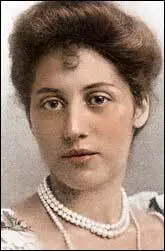
Sophia Duleep Singh, the sixth of seven children of Maharaja Duleep Singh (1838–1893) and his first wife, Bamba Müller (1848–1887), was born on 8th August 1876. Her father was exiled by the British at the annexation of the Punjab. A Sikh convert to Christianity was a naturalized British citizen, living on a pension of £25,000 per annum. Her mother was the daughter of Ludwig Müller, a partner in the German firm of merchant bankers Todd, Müller & Co. of Alexandria, and an Ethiopian woman. (1)
Maharaja Duleep Singh enjoyed the status of a senior aristocrat and was invited into all homes that mattered and was featured prominently at state occasions. Duleep Singh was popular with Queen Victoria: "He is extremely handsome and speaks English perfectly, and has a pretty, graceful and dignified manner. He was beautifully dressed and covered with diamonds.... I always feel so much for these poor deposed Indian Princes." (2)
Lena Login, whose husband was Duleep Singh's guardian, wrote: "His (Duleep Singh) candour and straightforwardness made him a great favourite with Queen Victoria and the Prince Consort. He was frequently invited to Windsor and Osborne." (3)
Queen Victoria & Maharaja Duleep Singh
On 30th March 1886, Maharaja Duleep Singh and his family decided to return to India against the wishes of the British government. However, he was intercepted and arrested in Aden. As he was taken away Duleep shouted: "I leave this ship unwillingly - my case will be the subject of a great state trial - before the House of Lords!" (4) On 6th May, he put his children and their mother on a ship destined for England. (5)
Queen Victoria was furious with the Maharaja who she felt had "been led astray". She agreed that "some money should be settled on his wife and children... and enough given him to enable him to live as a nobleman in England." The Queen argued: "It is most important that his Indian advisers and relatives should be kept from him for they are those who have brought him to this pass." (6)
Death of Parents
Maharaja decided to live in France and therefore abandoned his family. He also began to question the authority of Victoria. She wrote in her journal that "the unfortunate Maharaja Duleep Singh has published a most violent, crazy letter, speaking of being "the lawful Sovereign of the Sikhs" and "England's implacable foe." (7)
Sophia developed typhoid at the age of 10 on 17th September, 1887. Her mother, stayed by her daughter's bedside all night, praying for her fever to break. When one of her servants came into Sophia's bedroom the next morning they discovered her sleeping peacefully. On the floor by her bed lay her mother, cold and dead. According to her doctor she had "suffered comprehensive renal failure brought on by acute case of diabetes, exacerbated by her drinking and the stress of her daughter's illness." (8)
Queen Victoria wrote: "The poor Maharani died of all the worries she went through and his desertion of her. The children (of whom there are six!) - will be well cared for, have good guardians and allowance and kind people with them and I shall see them whenever I can. Would to God! I had done some more of late with the poor Maharajah! But really the family had become so large and so much to do about them that it was difficult to do and besides the extreme shyness of the Maharani made it more difficult to see much of them." (9)
Maharaja Duleep Singh lived in exile in Paris. He began a relationship with Ada Weatherill, a chambermaid from Lambeth. Only sixteen she worked at Cox's Hotel in St James, a discreet establishment that was well-known for providing wealthy men and their mistresses with rooms. Julian Osgood Field commented that Ada's many charms were only spoilt by her accent: "her pronunciation and the expressions she used were, to say the least, abnormal." (10)
In 1889 Duleep married Ada, whose first child was born just two months after Bamba's death. However, Duleep's health was poor and he died on 21st October 1893. Queen Victoria wrote to his eldest son, Victor. "I need hardly say how I like to dwell on former years when I knew your dear father so well, saw him so often and we were all so fond of him. He was so handsome so charming. But I will not dwell on the few after years which followed, which were so painfull... Pray accept this expression of my warmest sympathy in your heavy loss and convey the same to your brothers and sisters." (11)
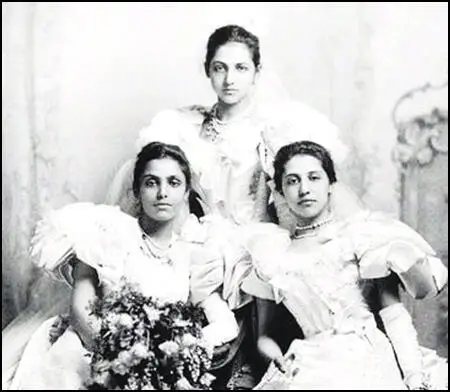
the left and Sophia Duleep Singh on the right (1892)
The India Office decided that the five girls, Bamba, Catherine, Sophia and Ada's two daughters, Pauline and Irene, would "receive about £22,000 each, or about £600 a year each, and the two elder ones £10,000 on marriage. The government never explained why Sophia would not, like her sisters, be provided with a dowry. Victor was granted £5,000 a year and Freddie £2,000. Over the next few years Victor gambled away most of his money. (12)
Education of Sophia Duleep Singh
Sophia's two older sisters, Bamba Duleep Singh and Catherine Duleep Singh, were educated at Somerville College, Oxford University. (13) Sophia was sent to a school run by a Miss Parkinson in Brighton. On 22nd June 1894, Sophia's guardian, Arthur Oliphant wrote to Sir Henry Ponsonby, Queen Victoria's Private Secretary about her progress: "I am glad to say she is doing very well at Brighton. She will terminate her four years stay at Miss Parkinson's school there next month - and her desire is to go to reside in a German family for six months to complete her education in German." (14)
It was suggested by Queen Victoria that Sophia should embark on a world tour. The plan was for her to stay in Germany for four months, with a further two months's travel around the Mediterranean on their way home. Sophia visited Greece, Egypt and Italy, studying the classics and improving their knowledge of the world. Miss Lina Schaeffer and two ladies' maids accompanied Sophia on her journey. She especially enjoyed her time in Florence, Naples, Milan and Venice. (15)
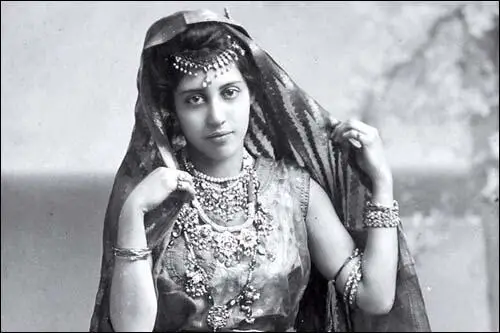
Queen Victoria felt an obligation to provide for Sophia, her goddaughter, and therefore on her return to the country she was granted Faraday House, a resistance opposite Hampton Court Palace on the Crown estates. It had this name because the scientist Michael Faraday had originally been given this house in recognition of his work in the fields of electromagnetic induction and electrochemistry. The house had five bedrooms. At the side of the house, a narrow path led to a four-bedroom cottage that served as quarters for the housekeeper and chauffeur. (16)
Prince Victor Duleep Singh married Lady Anne Coventry, the youngest daughter of George William Coventry, the 9th Earl of Coventry, on 4th January, 1898. Sophia and Bamba were both bridesmaids at the wedding. (17) According to The Sketch at the wedding "they first made their appearance in Society". (18) The marriage created a sensation: it was the first time an Indian prince had married an English noblewoman. Although Queen Victoria gave the couple her blessing, she allegedly told Lady Anne to never have children with the Prince. (19)
The The Sketch reported that "Princess Sophia Duleep Singh was well-known in sporting circles... and devoted to animals of all kinds. She is a fine horsewoman and when chaperoned by some English lady of rank often follows the hounds." (20) She was considered to be a "New Woman" smoking twenty Turkish cigarettes a day, and often appeared in the pages of the cycling magazines on her Columbia 41 Ladies' safety bicycle. (21)
Princess Sophia developed a reputation for breaking the law. The Truth reported: "When I referred two or three weeks back to the case in which Princess Sophia Duleep Singh was fined at Burton for driving out with an unmuzzled lapdog (a small pampered dog) in her carriage, I rather sympathised with the lady, though I did not see how the conviction could have been avoided. It would seem, however, that Princess Duleep Singh pays scant respect to any regulation which does not meet with her approval, for she has now been summoned before the Swadlincote magistrates for a second similar offence committed the day after she was fined at Burton. However much she dislikes it, even the Princess Duleep Singh must be taught to obey the law, and, as she deliberately disregarded the first lesson which she received, the Bench might well have enforced the second by imposing a more substantial penalty than a fine of two shillings and costs." (22)
Women's Social and Political Union
In 1909 Sophia Duleep Singh became converted to the cause of women's suffrage at the home of Una Dugdale. (23) Dugdale had first heard Christabel Pankhurst speaking in Hyde Park in the summer of 1907. She watched as "Christabel roared and gestured like a woman possessed, denouncing injustices perpetrated against women and children by an uncaring patriarchy." (24) She joined the Women Social & Political Union (WSPU) and toured the country with Emmeline Pankhurst helping her to recruit more women to the cause. (25) Sophia joined the Richmond and Kew branch of the WSPU whereas her sister, Catherine Duleep Singh, became an active member of the Esher and Molesey branch. (26)
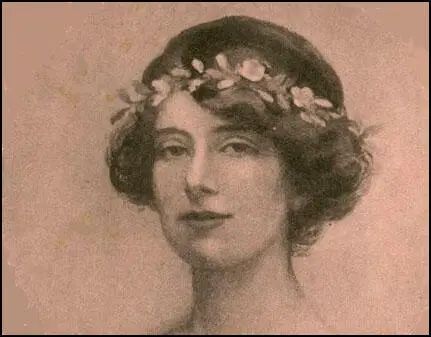
In January 1910, H. H. Asquith called a general election in order to obtain a new mandate. However, the Liberals lost votes and was forced to rely on the support of the 42 Labour Party MPs to govern. Henry Brailsford, a member of the Men's League For Women's Suffrage wrote to Millicent Fawcett, the leader of the National Union of Woman's Suffrage Societies (NUWSS), suggesting that he should attempt to establish a Conciliation Committee for Women's Suffrage. "My idea is that it should undertake the necessary diplomatic work of promoting an early settlement". (27)
Emmeline Pankhurst, the leader of the WSPU agreed to the idea and they declared a truce in which all militant activities would cease until the fate of the Conciliation Bill was clear. A Conciliation Committee, composed of 36 MPs (25 Liberals, 17 Conservatives, 6 Labour and 6 Irish Nationalists) all in favour of some sort of women's enfranchisement, was formed and drafted a Bill which would have enfranchised only a million women but which would, they hoped, gain the support of all but the most dedicated anti-suffragists. (28) Fawcett wrote that "personally many suffragists would prefer a less restricted measure, but the immense importance and gain to our movement is getting the most effective of all the existing franchises thrown upon to woman cannot be exaggerated." (29)
The Conciliation Bill was designed to conciliate the suffragist movement by giving a limited number of women the vote, according to their property holdings and marital status. After a two-day debate in July 1910, the Conciliation Bill was carried by 109 votes and it was agreed to send it away to be amended by a House of Commons committee. However, when Keir Hardie, the leader of the Labour Party, requested two hours to discuss the Conciliation Bill, H. H. Asquith made it clear that he intended to shelve it. (30)
Emmeline Pankhurst was furious at what she saw as Asquith's betrayal and on 18th November, 1910, arranged to lead 300 women from a pre-arranged meeting at the Caxton Hall to the House of Commons. Pankhurst and a small group of WSPU members, were allowed into the building but Asquith refused to see them. Women, in "detachments of twelve" marched forward but were attacked by the police. (31)
Sophia Duleep Singh volunteered to be a member of the deputation. Diane Atkinson, the author of Rise Up, Women!: The Remarkable Lives of the Suffragettes (2018), pointed out: "It was an offer Mrs Pankhurst could not refuse: what stronger point could be made when someone from such a privileged background was prepared to risk the opprobrium of her royal patrons by deliberately placing herself at the heart of such a protest." (32)
It is reported that 159 women and three men were arrested during this demonstration. (33) This included Ada Wright, Catherine Marshall, Eveline Haverfield, Anne Cobden Sanderson, Mary Leigh, Vera Holme, Louisa Garrett Anderson, Kitty Marion, Gladys Evans, Cecilia Wolseley Haig, Maud Arncliffe Sennett, Clara Giveen, Eileen Casey, Patricia Woodcock, Vera Wentworth, Mary Clarke, Florence Canning, Henria Williams, Lilian Dove-Wilcox, Minnie Turner, Lucy Burns and Grace Roe. (34)
Sylvia Pankhurst later described what happened on what became known as Black Friday: "As, one after the other, small deputations of twelve women appeared in sight they were set upon by the police and hurled aside. Mrs Cobden Sanderson, who had been in the first deputation, was rudely seized and pressed against the wall by the police, who held her there by both arms for a considerable time, sneering and jeering at her meanwhile.... Just as this had been done, I saw Miss Ada Wright close to the entrance. Several police seized her, lifted her from the ground and flung her back into the crowd. A moment afterwards she appeared again, and I saw her running as fast as she could towards the House of Commons. A policeman struck her with all his force and she fell to the ground. For a moment there was a group of struggling men round the place where she lay, then she rose up, only to be flung down again immediately. Then a tall, grey-headed man with a silk hat was seen fighting to protect her; but three or four police seized hold of him and bundled him away. Then again, I saw Miss Ada Wright's tall, grey-clad figure, but over and over again she was flung to the ground, how often I cannot say. It was a painful and degrading sight. At last, she was lying against the wall of the House of Lords, close to the Strangers' Entrance, and a number of women, with pale and distressed faces were kneeling down round her. She was in a state of collapse." (35)
Several women reported that the police dragged women down the side streets. "We knew this always meant greater ill-usage.... The police snatched the flags, tore them to shreds, and smashed the sticks, struck the women with fists and knees, knocked them down, some even kicked them, then dragged them up, carried them a few paces and flung them into the crowd of sightseers." (36)
The photograph of Ada Wright on the front page of The Daily Mirror the next day caused a great deal of embarrassment to the Home Office and the government demanded that the negative be destroyed. (37) Wright told a reporter that she had been at seven suffragette demonstrations, but had "never known the police so violent." (38) Charles Mansell-Moullin, who had helped treat the wounded claimed that the police had used "organised bands of well-dressed roughs who charged backwards and forwards through the deputations like a football team without any attempt being made to stop them by the police." (39)
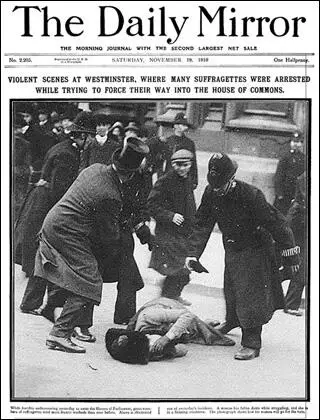
Sylvia Pankhurst believed that Winston Churchill, the Home Secretary, had encouraged this show of force. "Never, in all the attempts which we have made to carry our deputations to the Prime Minister, have I seen so much bravery on the part of the women and so much violent brutality on the part of the policeman in uniform and some men in plain clothes. It was at the same time a gallant and a heart-breaking sight to see those little deputations battling against overwhelming odds, and then to see them torn asunder and scattered, bruised and battered, against the organized gangs of rowdies. Happily, there were many true-hearted men in the crowd who tried to help the women, and who raised their hats and cheered them as they fought. I found out during the evening that the picked men of the A Division, who had always hitherto been called out on such occasions, were this time only on duty close to the House of Commons and at the police station, and that those with whom the women chiefly came into contact had been especially brought in from the outlying districts. During our conflicts with the A Division they had gradually come to know us, and to understand our aims and objects, and for that reason, whilst obeying their orders, they came to treat the women, as far as possible, with courtesy and consideration. But these men with whom we had to deal on Friday were ignorant and ill-mannered, and of an entirely different type. They had nothing of the correct official manner, and were to be seen laughing and jeering at the women whom they maltreated." (40)
Government ministers were upset that Princess Sophia was involved in this major demonstration. The Sketch reported: "One of the latest rebelling daughters is the Princess Sophia Duleep Singh but her participation in the recent raid did not cause much consternation in the Coventry circle as it would have done but for her pledge not to force her way into a reluctant gaol… The events of the last few weeks have somewhat daunted, not the dauntless Suffragettes, but all their friends." (41)
Sophia Duleep Singh was an energetic fund-raiser for Women Social & Political Union (WSPU) , in April 1911 she contributed cake and sweets for the opening of the Pankhursts' Streatham tea-shop. (42) Sophia Duleep Singh was also encouraged to speak at WSPU meetings. This included a meeting in Richmond on 9th April 1911 that was due to be addressed by Elizabeth Garrett Anderson and Laurence Housman. She eventually agreed to do this but warned them: "I will come on the 9th to the meeting with pleasure. I hope you have found someone else to support the resolution, if not I will do so, but very much prefer not to and I shall only say about five words." (43) Votes for Women reported that Princess Sophia was a very generous donor to the WSPU. (44)
Women's Tax Resistance League
In October 1909 the Women's Freedom League (WFL) established the Women's Tax Resistance League (WTRL). (45) Dora Montefiore was the first person who refused to pay her taxes until women were granted the vote. Outside her home she placed a banner that read: “Women should vote for the laws they obey and the taxes they pay.” As she explained: "I was doing this because the mass of non-qualified women could not demonstrate in the same way, and I was to that extent their spokeswoman. It was the crude fact of women’s political disability that had to be forced on an ignorant and indifferent public, and it was not for any particular Bill or Measure or restriction that I was putting myself to this loss and inconvenience by refusing year after year to pay income tax, until forced to do so by the powers behind the Law." (46)
The first member to take part in the campaign was Dr. Octavia Lewin. It was reported in The Daily Chronicle that the "First Passive' Resister", was was to be taken to court. It was announced in the same report that "the Women's Freedom League intends to organise a big passive resistance movement as a weapon in the fight for the franchise." (47)
Sophia Duleep Singh was one of the first women to sign up as someone willing to be a tax resister. She knew that this was a dangerous move. The courts warned the women that if they refused to pay, they risked the enforced seizure and sale of their property and the worst offenders would be sent to prison. (48)
In May 1911, at Spelthorne petty sessions, Sophia Duleep Singh's refusal to pay licences for her five dogs, carriage, and manservant led to a fine of £3. In July 1911, against arrears of 6s. in rates, she had a seven stone diamond ring impounded and auctioned at Ashford for £10. The ring was bought by a member of the Women's Tax Resistance League and returned to her. (49)
In December 1913 she was summoned again to Feltham police court for not paying her taxes. "The Princess Sophia Duleep Singh, residing at Hampton Road, Hampton Court, attended at Feltham Police Court yesterday upon summonses for refusing to pay taxes... She employed a groom without a licence, and also kept two dogs and a carriage without payment of the necessary licence. She came to court wearing the badge and medal of the Tax Resistance League and was accompanied by six other ladies including the secretary of the league, Mrs Kineton Parkes." (50)
In court she made a statement explaining her reasons for not paying her taxes: "I am unable conscientiously to pay money to the state, as I am not allowed to exercise any control over its expenditure, neither am I allowed any voice in the choosing of members of Parliament, whose salaries I have to help to pay. This is very unjustified. When the women of England are enfranchised and the State acknowledges me as a citizen, I shall, of course, pay my share willingly towards its upkeep, if I am not a fit person for the purposes of representation, why should I be a fit person for taxation?" (51)
Sophia Duleep Singh's refusal to pay a fine of £12 10s. resulted in a pearl necklace, comprising 131 pearls, and a gold bangle studded with pearls and diamonds, being seized under distraint and auctioned at Twickenham town hall, both items being bought by members of Women's Tax Resistance League, the necklace fetching £10 and the bangle £7. "Such actions were a means of achieving publicity. Members of the WTRL, by buying articles under distraint, and organizing protest demonstrations and meetings after the auction, generated interest and sympathy in the movement." (52)
Militant Suffragette
Large numbers of Women Social & Political Union members left the organisation when it increased its violent actions. However, Sophia Duleep Singh, fully supported the campaign. Public opinion began to turn against the WSPU when letters in pillar boxes were found soaked in a concentrated solution of potassium permanganate; the letters inside were completely ruined. When pillar boxes in Richmond were attacked with bottles of ink, tar and burning rags, some people suggested that Sophia might be responsible for this outrage. (53)
Sophia Duleep Singh also began selling the WSPU newspaper, The Suffragette, outside the gates of Hampton Court Palace. William Carrington, Keeper of the Privy Purse, complained to the Robert Crewe-Milnes, 1st Marquess of Crewe, Secretary of State for India. He replied to Carrington saying: "I have shown this to Lord Strathfordham who thinks the Lord Chamberlain is the person to warn the lady that she must not make herself compromised at Hampton Court, or in the immediate neighbourhood." (54)
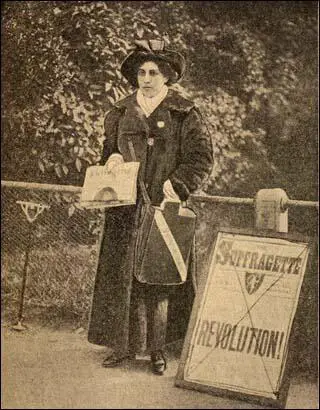
King George V was asked about the possibility of evicting Sophia Duleep Singh from Faraday House. He refused because he feared the publicity the act would receive. Instead the king decided to close Hampton Court Palace to the public. The loss of visitors to the tourist attraction was crippling local businesses, especially the restaurants and nearby hotels. Newspapers sent photographers to capture Sophia selling The Suffragette outside Hampton Court Palace. (55)
First World War
The British government declared war on Germany on 4th August 1914. Two days later, Millicent Fawcett, the leader of the NUWSS declared that the organization was suspending all political activity until the conflict was over. Fawcett supported the war effort but she refused to become involved in persuading young men to join the armed forces. This WSPU took a different view to the war. It was a spent force with very few active members. According to Martin Pugh, the WSPU were aware "that their campaign had been no more successful in winning the vote than that of the non-militants whom they so freely derided". (56)
Christabel Pankhurst wrote an article in The Suffragette where she argued: "A man-made civilisation, hideous and cruel enough in time of peace, is to be destroyed... This great war is nature's vengeance - is God's vengeance upon the people who held women in subjection... that which has made men for generations past sacrifice women and the race to their lusts, is now making them fly at each other's throats and bring ruin upon the world... Women may well stand aghast at the ruin by which the civilisation of the white races in the Eastern Hemisphere is confronted. This then, is the climax that the male system of diplomacy and government has reached." (57)
Emmeline Pankhurst said that militancy would be pointless in the face of the infinitely greater violence of war. "What will come out of this European war - so terrible in its effects on the women who had no voice in averting it - so baneful in the suffering it must necessarily bring on innocent children - no human being can calculate. But one thing is reasonably certain, and that is that the Cabinet changes which will necessarily result from warfare will make future militancy on the part of women unnecessary. no future Government will repeat the mistakes and the brutality of the Asquith Ministry." (58)
The WSPU carried out secret negotiations with the government and on the 10th August the government announced it was releasing all suffragettes from prison. In return, the WSPU agreed to end their militant activities and help the war effort. Christabel Pankhurst, arrived back in England after living in exile in Paris. She told the press: "I feel that my duty lies in England now, and I have come back. The British citizenship for which we suffragettes have been fighting is now in jeopardy." (59)
After receiving a £2,000 grant from the government, the WSPU organised a demonstration in London. Members carried banners with slogans such as "We Demand the Right to Serve", "For Men Must Fight and Women Must Work" and "Let None Be Kaiser's Cat's Paws". At the meeting, attended by 30,000 people, Emmeline Pankhurst called on trade unions to let women work in those industries traditionally dominated by men. She told the audience: "What would be the good of a vote without a country to vote in!". (60)
Just days before Christmas 1914, the first Indian casualties were brought to England. It was decided to turn the Royal Pavilion in Brighton into a hospital for the wounded soldiers. Nine separate kitchens had to be built in order to cater for the complex dietary requirements of the Indian men with their diverse faiths. There were separate taps for Hindus and Muslims, and a Sikh temple was erected on the lawns of the Royal Pavilion. (61)
Sophia Duleep Singh visited the Indian soldiers in Brighton but by 1915 she had joined the nursing staff. As Anita Anand, the author of Sophia: Princess, Suffragette, Revolutionary (2015), has pointed out: "It was the first time many of the men had seen an Indian woman in months, though Sophia was a mystery to them at first. She may have looked like the women they had left at home but she spoke hardly a word of Hindustani and most of the white nurses could communicate better than she could. When they found out who Sophia really was, their confusion turned to awe." (62)
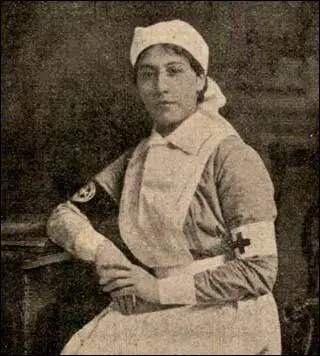
Sikh soldiers asked Sophia Duleep Singh for signed photographs so that they could prove to their families that they had truly met the daughter of the Maharaja Duleep Singh. Sophia did give the men signed photographs but felt they deserved something better. She managed to get little ivory shaving mirrors made up for the soldiers in her care. She also wrote personal messages on the back. (63)
On 17th July 1915, Sophia Duleep Singh was part of the 10,000-strong women's war work procession led by Emmeline Pankhurst. Officially sanctioned, it was paid for by the Ministry of Munitions. Pankhurst titled it the "Women's Right to Serve", a notion that enabled the WSPU to take over the mobilisation of the female work force for the munitions factories - a task that had proved problematic for the government - but on the strict condition that the women would receive equal pay for equal work. At Hyde Park the women were addressed by David Lloyd George. (64)
Women's India Association
In 1919 the Government of India Bill started its journey through the House of Commons. Groups were invited to give evidence before a Parliamentary Joint Select Committee. One group who wanted to put forward their ideas on the subject was the Women's Indian Association whose president was Annie Besant. The group had lobbied for equal rights since its creation two years before and was outraged that women had been entirely left out of the proposed new democratisation. Besant, now aged seventy-two, had devoted her final years to the cause of Indian Home Rule. (65)
Sophia Duleep Singh was a member of the delegation that gave evidence to the Parliamentary Joint Select Committee. The women argued their case passionately, warning the British government that if they made no provision for women's votes, they would be introducing gender equality to India deliberately and catastrophically. The women gave evidence before Edwin Montagu, Secretary of State for India: "Facing Mr. Montagu, who in spite of the odds against him, is bent upon putting India upon the path of responsible self-government, sat in a long-row, Mrs Naidu, the Princess Sophia A. Duleep Singh, Mrs Annie Besant, Mrs P. L. Roy, Mrs Kotwal, Mrs N. C. Sen, Mrs B. Bhola Naath and Mrs Dube." (66)
Montagu refused to change his bill. He would leave it to the provincial assemblies to decide if they wanted to give women the vote. Two years later, only some of them took up the opportunity. Madras was the first to grant women's suffrage in 1921, but only to those men and women who owned land property according to British administration's records. The rights granted in response to the movement towards suffrage were limited to qualifications of literacy and property ownership, including property ownership of husbands. This excluded vast majority of Indian women and men from voting, because they were poor. (67)
Later Life
After the First World War Princess Sophia had financial problems and could no longer afford to heat the rooms in Faraday House. In March 1920 she wrote to the Secretary of State for India, begging him for financial help: "Dear Mr Montagu, the great rise in prices, taxes and rates, and the ever increasing difficulty of making two ends meet, leave me no choice but to writer to you to ask for assistance." (68)
The government accepted the argument that the cost of living had gone up thanks to inflation, just under £20 was added to her annual allowance. Three years later her allowance was reduced by £70 a year. She complained: "I have received your letter of October 18 with regard to the reduction of the allowance from £200 to £130.68 a year. As it was not sufficiently adequate in the first place to cover expenses, it will be much less so when reduced... I am again obliged to use capital, which will further reduce my income." (69)
Princess Sophia remained committed to the cause of votes for women and was an active member of the Suffragette Fellowship that had been established by Edith How-Martyn in 1926 to "perpetuate the memory of the pioneers and outstanding events connected with women's emancipation and especially with the militant suffrage campaign, 1905-14, and thus keep alive the suffragette spirit". (70)
Stanley Baldwin, wanted to change the image of the Conservative Party to make it appear a less right-wing organisation. In March 1927 He suggested to his Cabinet that the government should propose legislation for the enfranchisement of nearly five million women between the ages of twenty-one and thirty. This measure meant that women would constitute almost 53% of the British electorate. The Daily Mail complained that these impressionable young females would be easily manipulated by the Labour Party. (71)
Winston Churchill, the Chancellor of the Exchequer, was totally opposed to the move and argued that the affairs of the country ought not be put into the hands of a female majority. In order to avoid giving the vote to all adults he proposed that the vote be taken away from all men between twenty-one and thirty. He lost the argument and in Cabinet and asked for a formal note of dissent to be entered in the minutes. There was little opposition in Parliament to the bill and Equal Franchise Act became law on 2nd July 1928. (72)
As a result of the act all women over the age of 21 could now vote in elections. Many of the women who had fought for this right were now dead including Elizabeth Garrett Anderson, Barbara Bodichon, Emily Davies, Elizabeth Wolstenholme-Elmy, Constance Lytton and Emmeline Pankhurst. Some veterans of the campaign such as Millicent Fawcett, the leader of the NUWSS, was still alive and had the pleasure of attending Parliament to see the vote take place. That night she wrote in her diary: "It is almost exactly 61 years ago since I heard John Stuart Mill introduce his suffrage amendment to the Reform Bill on May 20th, 1867. So I have had extraordinary good luck in having seen the struggle from the beginning." (73)
In 1930 Sophia Duleep Singh was appointed president of the committee which provided flowers for Emmeline Pankhurst's statue. Her passionate commitment to the women's cause continued, as demonstrated by the fact that in the 1934 edition of Women's Who's Who she listed "Advancement of Women" as her one and only interest. (74)
Princess Sophia Duleep Singh died of cardiac failure on 22nd August 1948 at her home, Hilden Hall, Tylers Green, Chepping, Wycombe, Buckinghamshire; she was cremated at Golders Green on 26 August.
Primary Sources
(1) The Truth (8th October 1896)
When I referred two or three weeks back to the case in which Princess Sophia Duleep Singh was fined at Burton for driving out with an unmuzzled lapdog (a small pampered dog) in her carriage, I rather sympathised with the lady, though I did not see how the conviction could have been avoided. It would seem, however, that Princess Duleep Singh pays scant respect to any regulation which does not meet with her approval, for she has now been summoned before the Swadlincote magistrates for a second similar offence committed the day after she was fined at Burton. However much she dislikes it, even the Princess Duleep Singh must be taught to obey the law, and, as she deliberately disregarded the first lesson which she received, the Bench might well have enforced the second by imposing a more substantial penalty than a fine of two shillings and costs.
(2) The Sketch (13th January 1904)
Princess Sophia Duleep Singh, the sister of the two popular Anglo-Indian potentates who are well-known in sporting circles, is devoted to animals of all kinds. She is a fine horsewoman and when chaperoned by some English lady of rank often follows the hounds. There are two Princesses Duleep Singh Sophia and Bamba, and they first made their appearance in Society when acting as bridesmaids at the marriage of their elder brother, Prince Victor, to Lady Anne Coventry.
(3) The Sketch (7th December 1910)
One of the latest rebelling daughters is the Princess Sophia Duleep Singh but her participation in the recent raid did not cause much consternation in the Coventry circle as it would have done but for her pledge not to force her way into a reluctant gaol… The events of the last few weeks have somewhat daunted, not the dauntless Suffragettes, but all their friends.
(4) The Daily Mail (30th December, 1913)
The Princess Sophia Duleep Singh, residing at Hampton Road, Hampton Court, attended at Feltham Police Court yesterday upon summonses for refusing to pay taxes... She employed a groom without a licence, and also kept two dogs and a carriage without payment of the necessary licence. She came to court wearing the badge and medal of the Tax Resistance League and was accompanied by six other ladies including the secretary of the league, Mrs Kineton Parkes.
(5) Sophia Duleep Singh, speech in court, The Times (30th December, 1913)
I am unable conscientiously to pay money to the state, as I am not allowed to exercise any control over its expenditure, neither am I allowed any voice in the choosing of members of Parliament, whose salaries I have to help to pay. This is very unjustified. When the women of England are enfranchised and the State acknowledges me as a citizen, I shall, of course, pay my share willingly towards its upkeep, if I am not a fit person for the purposes of representation, why should I be a fit person for taxation?
(6) Votes for Women (2nd January 1914)
At the Feltham Police Court, summoned for keeping a manservant, two dogs and a carriage without licences, Princess Sophia Duleep Singh, fined in all £12 10s and costs.
(7) The Times (25th August, 1948)
Princess Sophia Alexandrovna Duleep Singh, third daughter of his Highness the late Maharaja Duleep Singh, died at Penn, Buckinghamshire on Sunday.
She had lived for many years in England and was prominent in the women's suffrage movement in the days before the 1914-18 war. Taking her stand on the principle that there should be no taxation without representation she several times refused to pay licence fees and allowed distress to be levied on her property to pay the amounts due.
In 1935 she lent to the Inverness Public Museum the magnificent collection of Jacobite relics assembled by Prince Frederick Duleep Singh.

